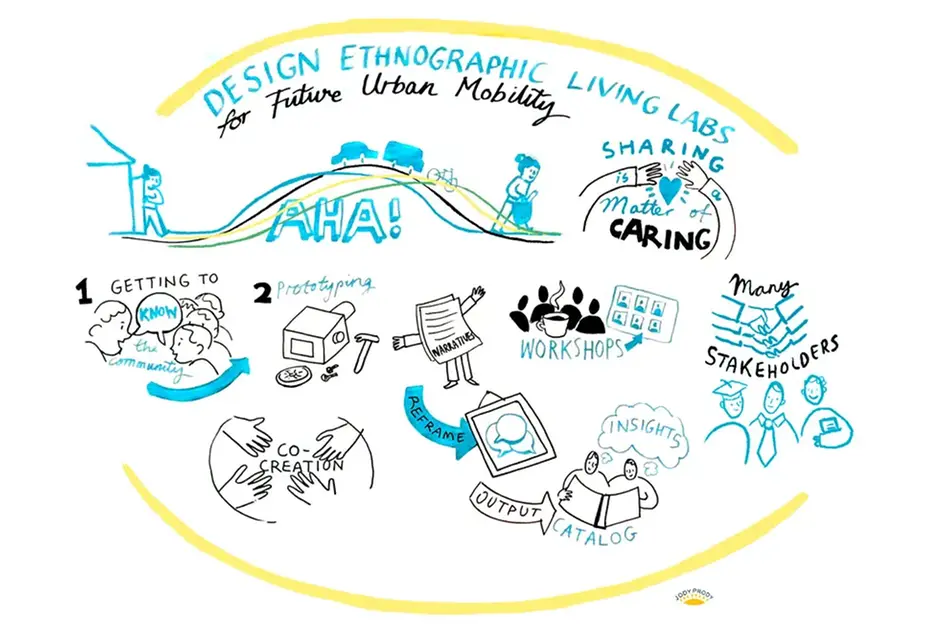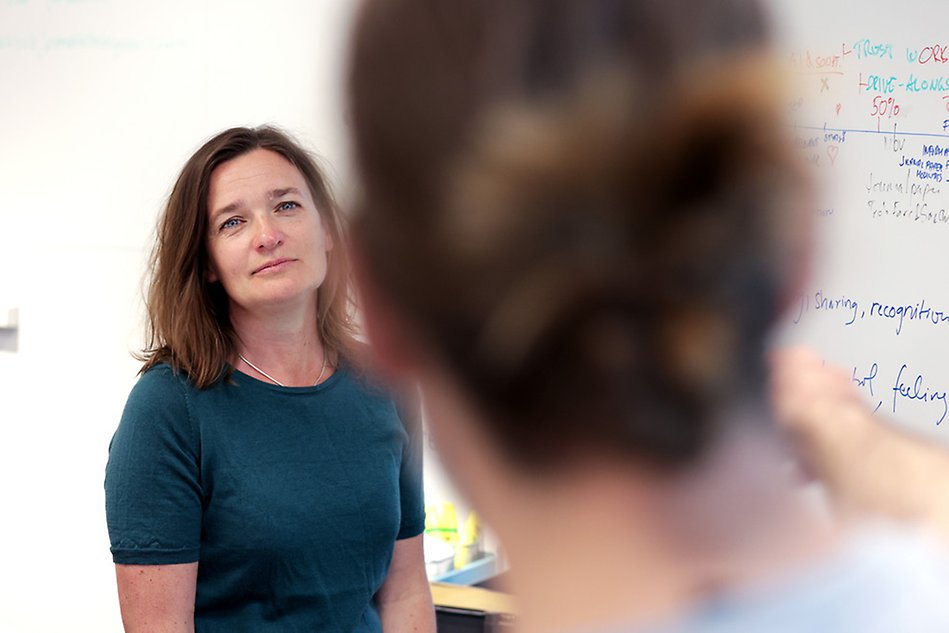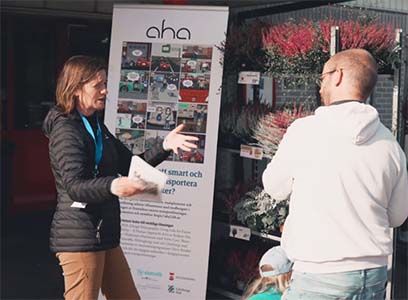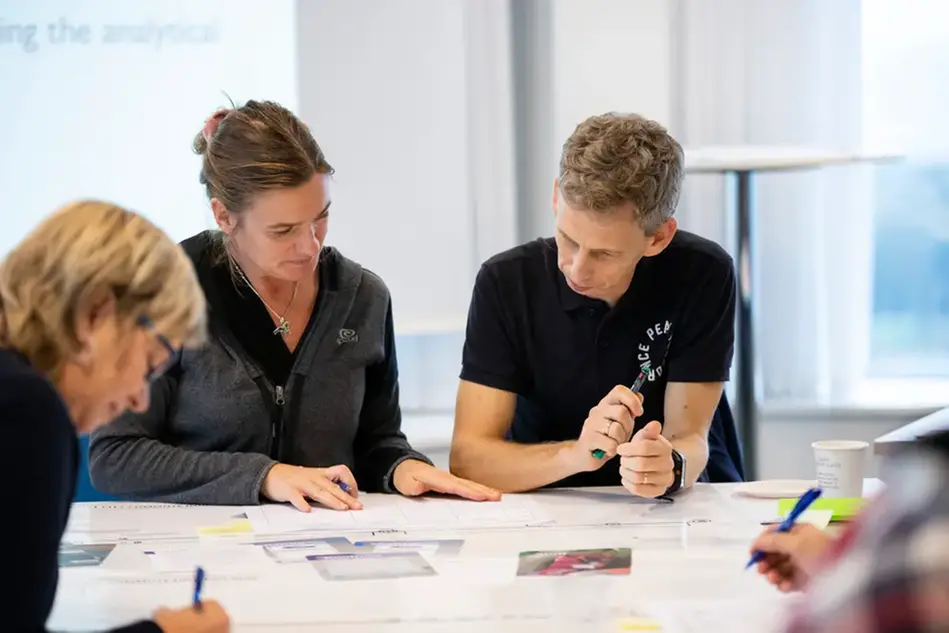Professor’s portrait: Our every-day-life is central in research about new technology
Understanding how humans are affected by technology development, and vice versa, is the driving force for Vaike Fors, newly appointed Professor in the unique field of Design Ethnography.
“I’m interested in people, their social lives and how they approach technology”, says Vaike Fors. Her motivation to contribute to technical solutions that are sustainable on both a social and a societal level, has led Vaike Fors to develop unique models and projects for human-centred and cross-disciplinary collaborations.
”I study how technology is used and becomes a part of our lives. It is only when technical solutions are used that they become meaningful.”
Vaike Fors, Professor of Design Ethnography

Vaike Fors, Professor of Design Ethnography.
After working as a teacher in primary school for a few years, Vaike Fors realised that she was more interested in what the students did during their breaks than in the classroom. She wanted to follow their development, rather than the curriculum, and therefore chose to engage in pedagogical research. Her PhD on how young people perceive interactive exhibitions was the starting point for Vaike Fors’s research carrier. She is now Sweden’s first Professor of Design Ethnography, a multifaceted field of research under development. Her expertise includes tailoring design ethnographic methods, to investigate how people interact and learn with emerging technologies, and what this means for their everyday lives, routines and habits.
“I study how technology is used and becomes a part of our lives. It is only when technical solutions are used that they become meaningful, often in a way that people find difficult describing in words. Ethnography as a methodological approach can make this visible. In design ethnography, that knowledge is the foundation for developing an understanding of technology and its design.”

In one of Vaike Fors's and her research team's projects, AHA II, citizens in Helsingborg and Gothenburg are involved through so-called Urban Living Labs in co-design of future local transport solutions. Illustration for AHA II by Jody Ghani.
Technology is integrated in our lives, but how?
In her research, Vaike Fors studies how people learn to live with new technology when it enters their lives and how that knowledge can be used; not only by further developing the design of the technology but also by questioning it. This is where the ethnographic part of her research comes in. It is based on how people experience different things, as well as how knowledge about it can be used to question and problematise new technology, such as the purpose and background, the idea behind a certain design and the expected effects of usage.
With a research background in pedagogy, Vaike Fors describes learning as an inevitable part of people's activities when they participate in social contexts. Much technological development takes place in relation to different types of desired behavioural changes, but Vaike Fors is more interested in how cultural and social patterns affect how people use technology in their everyday life.
“The human and societal aspects interest me, how behaviours are created by people in different situations and contexts. There is a lot of talk about the importance of studying and measuring behaviours when it comes to technology development, but the importance of understanding the context and the more qualitative question of why is often forgotten.”
Project: Self-tracking apps
One example of why people use a certain technology became clear in the international project Sensing, shaping, sharing: Imagining the body in a mediatized world, financed by Riksbankens Jubileumsfond and led by Vaike Fors. The four-year project studied, among other things, how people use self-tracking apps that measure physical activity and various body functions.
“By letting people show me how they use their self-tracking apps in their everyday life, I gained a completely different insight into the importance of this technology; why people start and stop using them. Based on this, it became interesting to analyse the intentions behind the design and reflect on what an alternative design could look like.”
Read more about the project:
Self tracking apps affect us – and we affect the apps with improvisation and fiddling
Important to close technology gaps
Several collaborative projects led by Vaike Fors are about future, sustainable and realistic mobility solutions, where Halmstad University collaborates with other universities, cities and the industry. Mobility solutions, i.e. the development of transportation vehicles and related services, require an understanding of how technology is used. To gain that understanding, different stakeholders need to collaborate interdisciplinary and not just in technological innovation.

Vaike Fors believes that there is a big gap in what society and industry want to develop, and what people know about the ongoing technological development. If that gap becomes too large, it is very difficult to produce useful new technology. According to Vaike Fors, there is a great need to have in-depth knowledge of how humans interact with technology, society and nature in technological development.
“Artificial intelligence, for example, interacts with humans in new ways. It is important that a wider public understands how that technology works in everyday life, and that more people can participate and develop what AI technology can and should be used for. Design ethnography is a methodology that can be utilized for such co-creative processes, where not only technology is important but where sustainability issues are absolutely central. It is of utmost relevance today.”
”We need to engage people with different backgrounds in many types of areas to reduce the gaps between what is being developed technically, what is being advocated by cities and what people know and care about when it comes to technology development.”
Vaike Fors, Professor of Design Ethnography
Project: OsMaaS
The OsMaaS project aims to develop Mobility as a Service (MaaS) platforms by using service design methods. In the project a multistakeholder and interdisciplinary team of resarchers and developers investigate the question of how MaaS can be designed for sustainable futures. Vaike Fors is leading the Design Ethnographic subproject within OsMaas to bring in the everyday routines, habits, experiences and expectations into speculations of how future mobility scenarios can look like.
Project page for OsMaas:
OSMaaS – Designing Open and Self Organising Mechanisms for Sustainable Mobility as a Service
Since 2017, Vaike Fors holds a seat in the program office for one of Sweden's 17 Strategic Innovation Programs, Drive Sweden. From this position, she has been able to follow parts of new technology development closely. Drive Sweden's focus is to create sustainable, secure, and accessible connected and automated mobility solutions. Vaike Fors leads the thematic area Public Engagement within Drive Sweden.
“It feels very meaningful to be involved in and develop the thematic area. We need to engage people with different backgrounds in many types of areas to reduce the gaps between what is being developed technically, what is being advocated by cities and what people know and care about when it comes to technology development.”
About Drive Sweden
Drive Sweden is a Strategic Innovation Program (SIP) that focuses on creating a mobility system of the future for people and goods that are sustainable, safe and accessible for all. Drive Sweden's work is divided into five thematic areas, one of which is Public Engagement, led by Vaike Fors.
The Strategic Innovation Programs are funded by VINNOVA, the Swedish Innovation Agency, the Swedish Research Council Formas and the Swedish Energy Agency. Drive Sweden is hosted by Lindholmen Science Park AB.
More information:
Drive Sweden External link, opens in new window.
External link, opens in new window.
Thematic area Public Engagement External link, opens in new window.
External link, opens in new window.
New needs and values emerge when involving residents
Several traditionally technology-driven industries, such as automotive and power companies, are shifting towards a more human-centred development based on people's needs and usage, rather than only the technical possibilities.
In one of Vaike Fors's and her research team's projects, AHA II, citizens in Helsingborg and Gothenburg are involved through so-called Urban Living Labs in co-design of future local transport solutions. The purpose is to develop future mobility solutions situated in local contexts.

Vaike Fors is talking with a citizen.
“In the project, we involve groups of people in types of neighbourhoods who are not usually considered when developing new technology. We visit their home environments to talk about the area and what life looks like there. We have done ethnographic fieldwork and design-oriented workshops together with the residents to understand local interests, values and knowledge. From this, we can start framing possible future scenarios for urban development and generate locally situated prototypes.”
Project: Urban Living Labs
The project that includes the Urban Living Labs in Helsingborg and Gothenburg is called AHA II, Design ethnographic living labs for future urban mobility – A human approach. Project results show other needs and values than previous user studies.
“Those who are usually asked in studies of future mobility are often people who are already convinced – potential customers for new and expensive solutions. But in these areas, we see other local cultures than what previous user studies have shown. Those cultures often prioritise other aspects than what is usually highlighted as benefits of new mobility services, such as saving time. But who wants to make their journey from work more time efficient when an important part of the trip home is to take a detour past the local shop to chat with neighbours and friends?"
Read more about Vaike Fors's future mobility projects:
A human approach to designing future cities and intelligent cars
Sharing insights in people's everyday lives
Major cities around the world, such as Singapore, London and Paris, have closed parts of the city centres to private car traffic. At the same time, the car industry is developing technology solutions that cities may not be familiar with. According to Vaike Fors, the communication between cities and industries is not always ideal, as they have different goals. It is also difficult to find common ground for the stakeholders to meet at.
“We have discovered that our design ethnographic projects create a common ground for the industry and cities, where they can meet and discuss what it really means to have a human-centred perspective. Insights into people's everyday lives have proven to function as a good starting point for collaboration. Talking about how people solve their daily transport means that you can partly step out of your own agenda and meet others in a discussion about what the different stakeholders can contribute with to simplify for the very people that you are talking about.”

Vaike Fors and PhD student Thomas Lindgren during a workshop about future commuting that gathered car developers, urban planners and design researchers. The workshop led to a collection of ideas of how people’s everyday routines can be addressed for an increased value for cities and their citizens as well as business actors.
It is not only the researchers who want to put people at the centre – the industry is also keen on it, but in technology-heavy companies, new perspectives are needed to succeed. That is why companies such as Volvo Cars, among others, have chosen to collaborate with the research team at Halmstad University, for example by employing two industrial PhD students within Informatics. Vaike Fors is the main supervisor for these industrial PhD students and can see that there is great interest in a design ethnographic approach.
“It takes time to develop a human and society-oriented approach in technology-heavy environments. But, with the ongoing development of service design connected to mobility solutions, moving from the production of cars to providers of mobility services, new methods are needed. Therefore, design ethnography is a very timely approach.”
Project: RELEVANT
In the project RELEVANT, Realising Efficient Charging of Electric Cars with User-Centered Smart Technology, the goal is to map users' preferences and expectations of smart charging of electric and hybrid cars. The project is managed by Volvo Cars, and the other project partners are RISE, Vattenfall, Skellefteå Kraft and Kraftringen Energi. Within RELEVANT, the various stakeholders involved work together to develop user-friendly solutions for sustainable charging of vehicles. Vaike Fors supervises an industrial PhD student at Volvo Cars who follows test families to study how their experiences and expectations develop during the project and how they incorporate electric vehicles into the energy networks in their homes.
Read more about Vaike Fors's future mobility projects:
Project page for RELEVANT:
RELEVANT – Realising Efficient Charging of Electric Cars with User-Centered Smart Technology
Planet-centred development
When developing solutions for the transportation of goods and people, both a human-centred and a planet-centred approach is needed. In a newly started European sustainability project, Active8 Planet, Vaike Fors leads Halmstad University's participation. The project goal is for university students to learn how to think and act sustainably in their future profession. Through Active8 Planet, sustainability issues and interdisciplinary collaborations can be integrated into higher education.
“The purpose of the Active8 Planet project is to develop higher education so that students learn to think and act sustainably by taking advantage of the will for change that young people have. To be able to integrate sustainability issues into higher education, we must cooperate between universities, public actors and companies, and activate ourselves – teachers and researchers.”

The interest in sustainability issues among youths has increased in recent years. In Active8 Planet, not only methods for the best possible collaboration will be developed, but also how education should be changed to become more action-oriented when it comes to sustainability issues.
Project: Active8 Planet
Four European universities, three companies and two organisations are collaborating in Active8 Planet. The project runs for three years and is funded by EU Erasmus+. Students as well as teachers, researchers and industry partners will participate in the project. The focus is on developing methods for good collaborations, as well as how education should be changed to become more action-oriented when it comes to sustainability issues.
Read more about the project:
Students learn to think and act sustainably in new research project
Project page for Active8 Planet:
The teacher's heart beats for anthropological learning
When Vaike Fors looks at the world's economic and technological driving forces, she is doubtful; she believes that if we are to save the planet now, we must also look to other values, we must understand social life.
Part of that is to understand human learning processes – a consistent interest and focus for Vaike Fors. Her perspective on learning is anthropological, that is, to consider learning as situated in people's practices, and she nourish a methodological interest in creating interdisciplinary and tailoredethnographic approaches. She has, among other things, published books on visual methods as well as applied social science. During the autumn of 2021, she is writing up the book Design Ethnographypublished by Routledge, together with an international group of researchers. The bookemphasises the importance of thinking of design ethnography as an interdisciplinary, interventional and pedagogical approach, with the ambition of creating processes that live on, even after a project period is over. It is a processual methodology, with a focus on creating learning design processes together with research participants and partners.
“I am interested in how people are involved in learning processes in general. Now, as a Professor of Design Ethnography, it gives me opportunities to immerse myself in and develop this approach in new projects, collaborations and application areas. For example, it would be very interesting to further develop our design ethnographic LivingLab in new environments”, concludes Vaike Fors.
Text: Karin Bergstrand and Louise Wandel
Photo: Emely Niemi Jonsson, Anna-Frida Agardson and Unsplash
Illustration: Jody Ghani for the AHA II project
About Vaike Fors
Vaike Fors was born in 1969 in Uppsala and grew up in Sollefteå. She studied to be a primary school teacher at Luleå University of Technology. In 2006, Vaike Fors defended her dissertation in pedagogy at Luleå University of Technology on the dissertation "The Missing Link in Learning in Science Centers". Between 2006 and 2009 she was a postdoctoral fellow at the University of Gothenburg and Stockholm University. Vaike Fors started at Halmstad University as Senior Lecturer in 2009, became an Associate Professor (Docent) of Pedagogy in 2016 and was appointed Excellent Teacher in 2019.
At Halmstad University, she has been a member of the research and education board, chair of the recruitment committee and member of the management group for profile area Smart Cities and Communities. Between 2013 and 2017, Vaike Fors initiated and led the strategic initiative SCACA (Swedish Center for Applied Cultural Analysis) at Halmstad University. To date, she has initiated and led about fifteen projects funded by the Knowledge Foundation, Vinnova, Riksbankens Jubileumsfond and the Swedish Research Council, often in collaboration with international universities, as well as private and public actors.
Since 2017, Vaike Fors has been an elected member of the program office for the national innovation program Drive Sweden. She has initiated and participated in three externally funded international networks. Since 2019, Vaike Fors is an Adjunct Associate Professor at Monash University in Melbourne, Australia, and act as partner investigator in the Center of Excellence 'Automated Decision-Making and Society' funded by the Australian Research Council between 2020 and 2027. Vaike Fors became Professor of Design Ethnography in 2021 at Halmstad University.
Vaike Fors's path to design ethnographic research on humans and new technology
“My research interest in design and ethnography began with my PhD project that I did in collaboration with a science centre in Luleå called Teknikens hus. They had a hard time capturing the interest of their main target group, teenagers. Using ethnographic methods, I let a group of teenagers film their visits and how they approached the interactive exhibitions. In this way, I became interested in how the pedagogical ideas behind the interaction design in the exhibitions were understood by the youth, from their perspective.”
“That relation became the spark for my postdoctoral research, which was about how to think new when it comes to the design of interactive exhibits. How to go from focusing only on the momentary and individual experience of interacting with a technical solution, to also understanding the interaction as part of people's life-based learning strategies, and the design implications this re-framing can end up in. By doing this, I developed my interest in technology design and ethnographic methodology, and that interest has led me into many exciting collaborations and technology areas. Now I have come to focus on what AI driven solutions mean in everyday routines, and that is fascinating.”

